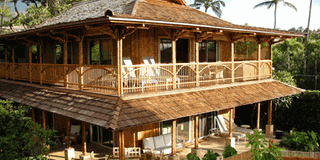Prime
Natural materials that minimise costs

Bamboo is used in house design and decor. It is a renewable material because it grows fast.
What you need to know:
Sandra Natukunda finds out some of the natural and locally available building materials you can build a house with.
When it comes to home or commercial building construction, the first thing that comes to mind is the huge expenses on building materials and their transportation among all the other costs involved in construction.
This is because most people venturing into construction prefer to use expensive materials like concrete and cement because they think these materials are not long lasting. They use less natural building materials like rock, sand and clay which are locally available and are pocket friendly.
According Mr Peter Bumba, a construction engineer with Jomayi Property Consultants, natural building materials and man-made materials are inter-dependent and work hand in hand.
“Usually, natural materials, when used during construction, need binding materials like cement and mortar which are factory-made. In other words, man-made materials are an improved version of natural building materials,” he explains.
Below are some of the natural materials you can consider using.
Rocks
Rocks are heavy and labour-intensive therefore difficult to transport compared to any other building materials. Although this comes as a disadvantage, rock is durable, readily available and if used on walls, it has a good thermal mass, which means that it absorbs the outside temperature, holds it in and radiate it through the home.
“In Uganda, there are few construction projects made of entirely rock because it is hardly used alone and needs binding material to hold it together,” Mr Bumba says.
He adds that rocks in order to be easily handled, must be crushed into small slates, blocks or rubble and are bonded using sand, cement or mortar. Also, rocks because of their robustness are used in water logged areas (swamps) to avoid capillary attraction (hardcore filling).
Bamboo
In most cases, bamboo has been fashionably used in home design and décor but it comes off as a renewable natural building material because it grows fast anywhere and it is locally available.
According to Mr Patrick Olonya, a contractor at Dott Services Limited, bamboo can be used as reinforcement (help the structure to stand on its own) because of its durability and resistance and can also be used for roofs.
However, its comparative advantage to other wood species is that it is naturally protected in a way that does not allow it to be eaten by ants
Straw bales
Although this is referred to as the most outdated natural building material, it is cheap and good for semi-permanent construction. For construction, straw bales are tightly packed together to form a structure or in another way, they are used to plaster the walls of an already finished construction.
The fear most people have about constructing with straw bales, is that they can easily catch fire yet it is argued that since the straw bales are tightly packed together, there is no oxygen to favour a fire. However, Mr Bumba advises that straw bales should not be used for permanent construction because they wither with weather.
Rammed earth
For many people, wood is neither affordable nor available, so resourceful builders and constructors use what they have: the ground beneath their feet. To build a rammed earth home, Mr Bumba explains that a mixture of soil is packed down into a temporary wall form that shapes the mixture usually in blocks. These blocks are made in a way that they are self-bonded and do not need binding material.
The form is usually wooden, and it must be strong enough to withstand the compression of the ramming. Ramming can either be done by hand or by machine but mostly by hand in order to cut costs, and once it’s completed, the forms can be removed, leaving an earthen wall.
Rammed earth walls require a cross-grade of soils, but too much clay may cause the walls to crack. When properly constructed, rammed earth walls are extremely durable being able to hold up in bad weather. In Uganda, this kind of natural building material is mostly used in Karamoja.
Cob
Cob construction is a mixture of clay straw grass and water. It is a cheap but creative, free-form construction that includes curvy shapes and sculptural forms, and it requires minimal tools or construction experience.
It can be used even for permanent construction projects because when the cob dries, it’s like concrete because of the reinforcement of the straw. However, waiting for the cob to dry is important before placing the next layer of cob lumps. Building on top of wet lumps will cause the building to sag, so cob building is time consuming.
From the above, natural building materials offer a way of constructing a house with renewable, natural and locally available materials as opposed to industrial or man-made materials.
With a variety of such natural building materials, you can pick the ones that suit your needs and minimise building costs.




